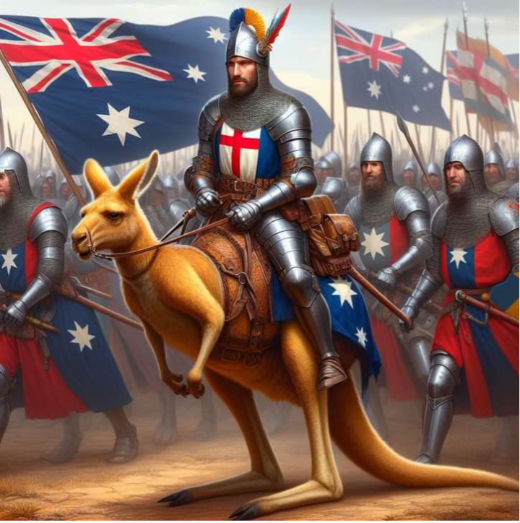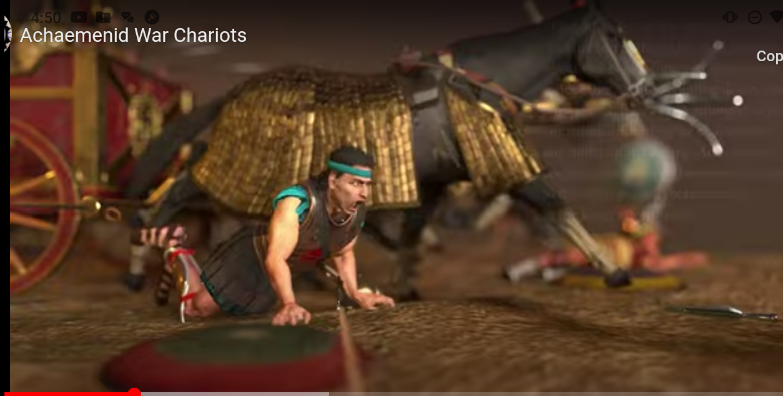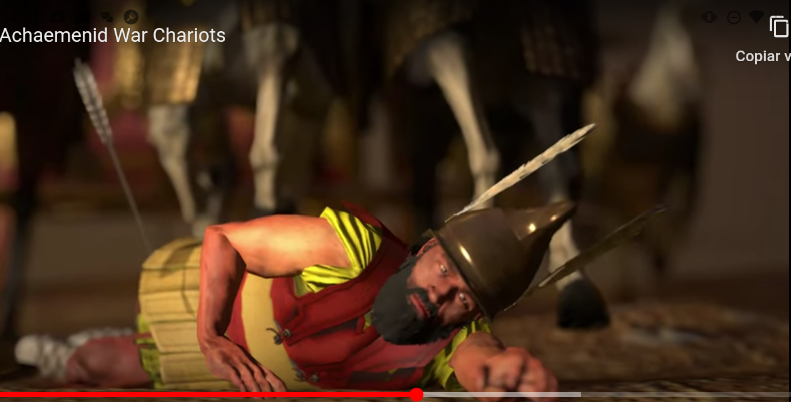-
Posts
25.684 -
Joined
-
Days Won
299
Everything posted by Lion.Kanzen
-
I'm going to make a post about technologies for the next alphas. It will not just be new technologies but new types of technologies.Reversible technologies. I need to have you help me with this @wowgetoffyourcellphone
-
When a new technology is introduced and there is no room to improve, it is best to downgrade the unit and the technology returns it to how it was before. We must downgrade the Kushite archer then upgraded by a tech. With that change. I know how angry they are going to be with that change. The downgrade thing is good to introduce new technologies and leave the units in their current state after going through technology. For example, you say and it seems correct to me that the units have a lot of LoS. The best thing would be to add one or 2 technologies (even more) to improve the LoS, but first the LOS would have to be reduced and then increased with new technologies to the current state. How much is the current LoS? How much is the actual kushite archer firing rating?
-
Thumb rings for Kushites. Bonus for archery units. Accuracy for shooting and faster firing. It would be necessary to rebalance if they already shoot quickly. https://ageofempires.fandom.com/wiki/Thumb_Ring Ethiopians are the equivalent to Kushites. The Ethiopian Archer line already fires 18% faster due to their civilization bonus and have access to Thumb Ring. As a result, they have the fastest firing foot archers in the game.
-
.thumb.png.ce58cea22940c255f5b0a735d5abee36.png)
[Units] Roles and New paradigm+A28
Lion.Kanzen replied to Lion.Kanzen's topic in Gameplay Discussion
Kushites champion archer Will be more like this. -
.thumb.png.ce58cea22940c255f5b0a735d5abee36.png)
[Units] Roles and New paradigm+A28
Lion.Kanzen replied to Lion.Kanzen's topic in Gameplay Discussion
Besides: All the references to a unit called "Hypaspists" are much later than the period of Philip, and modern historians have to assume[citation needed] that later sources, like Diodorus Siculus[7] (1st century BC) and Arrian,[8] had access to earlier records. Arrian's phrase tous kouphotatous te kai ama euoplotatous[9]) has frequently been rendered as 'lightest armed', although Brunt [10] concedes it is more properly translated as 'nimblest' or 'most agile' -
.thumb.png.ce58cea22940c255f5b0a735d5abee36.png)
[Units] Roles and New paradigm+A28
Lion.Kanzen replied to Lion.Kanzen's topic in Gameplay Discussion
But there are AoM Hypaspistai -
.thumb.png.ce58cea22940c255f5b0a735d5abee36.png)
[Units] Roles and New paradigm+A28
Lion.Kanzen replied to Lion.Kanzen's topic in Gameplay Discussion
Another controversial unit that may be interesting. Hypaspistai or Macedonian Champion I could go from being a hoplite to a swordman, even a commando swordman. The word may have had Homeric and heroic connotations that led Philip II of Macedon to use it for an elite military unit. This unit, known as the Hypaspistai, or hypaspists, was probably armed in the hoplite manner, with a large concave shield (Aspis) and a spear (Dory), in addition to spolas or linothorax body-armor, hoplite's helmet, greaves and a xiphos or kopis sword (though their equipment was likely more ornate than main-line soldiers In set piece battles, the Macedonian Hypaspists were positioned on the flanks of the phalangite's phalanx; in turn, their own flanks were protected by light infantry and cavalry. Their job was to guard the flanks of the large and unwieldy pike phalanx. The armored Phalangites with their sarissas were not particularly agile or able to turn quickly, so hypaspists would prevent attacks on the vulnerable sides of the formation. Their role was vital to the success of Philip's tactics because the Macedonian phalanx was all but invulnerable from the front, and was, with five layers of iron spikes moving in unison, used as the anvil in a hammer and anvil tactic, where the Companion cavalry was the hammer that smashed the enemy against an anvil of thousands of iron spikes. ---- It could be slow and lumbering in hoplite mode and fast and fast in commando mode. Even attack fast like the AoE I swordmen Their role is supposed to fill the gaps in the companion cavalry maneuvers to protect the pikeman infantry. I didn't find any good videos which tells us about the AoE I DE wasn't a popular game. -
.thumb.png.ce58cea22940c255f5b0a735d5abee36.png)
==[Brainstorming]== for cheats units
Lion.Kanzen replied to Lion.Kanzen's topic in Eyecandy, custom projects and misc.
- 198 replies
-
- 1
-

-
- brainstorming
- art
-
(and 2 more)
Tagged with:
-
.thumb.png.ce58cea22940c255f5b0a735d5abee36.png)
[Units] Roles and New paradigm+A28
Lion.Kanzen replied to Lion.Kanzen's topic in Gameplay Discussion
Another unit that should stand out as a champion is the Nubian (Kushite) archers. https://isac.uchicago.edu/museum-exhibits/nubia/nubian-archers Archers formed the core of Nubian armies that vied with Egypt for control over parts of the Nile valley, conquered Egypt in the 8th century BC, and confronted the troops of the Assyrian empire. The skill of Nubian archers made them valued members in the military forces of other lands. Egyptian texts as early as 2400 BC note Nubians in Egyptian armies. Representations of Nubian warriors appear in Egyptian tomb models, reliefs, and paintings in all periods of ancient Egyptian history. Nubian archers also served as warriors in the imperial army of Persia in the first millennium BC. Nubians used the bow throughout history Burials of northern Nubian rulers in the 5th century AD show that they still relied on the bow and arrow. Nubia’s elite warriors of the time loosed their arrows from horseback and employed thumb rings to increase the force and accuracy of their shots. In the 8th century Nubian archers fought back Muslim invaders. In their account of the event, the Muslims noted the accuracy of Nubian arrows that drove them away ________ As you can see, it is not a delicate unit, it is very fierce and brave. -
.thumb.png.ce58cea22940c255f5b0a735d5abee36.png)
[Units] Roles and New paradigm+A28
Lion.Kanzen replied to Lion.Kanzen's topic in Gameplay Discussion
In fact, the ideal is that the units with double function, at least the infantry ones, remain for a long time without being able to use the firing function, since it would be much more interesting if some of them had limited ammunition. That is why it is a paradigm. Because literally 0 AD units could be very flexible for tactics simulating a kind of war gaming, which would make it enter the realm of total war style without ceasing to be a classic rts with base building.(Which is precisely an experience that total war does not have the base building). -
.thumb.png.ce58cea22940c255f5b0a735d5abee36.png)
[Units] Roles and New paradigm+A28
Lion.Kanzen replied to Lion.Kanzen's topic in Gameplay Discussion
The only problem I see with that is infantry Romans firing 2 pilums each one And after that it will take a while to replace the pilums. -
.thumb.png.ce58cea22940c255f5b0a735d5abee36.png)
[Units] Roles and New paradigm+A28
Lion.Kanzen replied to Lion.Kanzen's topic in Gameplay Discussion
The idea is to use units that are multifunctional those units that it is very questionable what weapon they used. I remember that in his time the units peltasts era multi task we can called multi role. Consider the following: "Peltasts became the main type of Greek mercenary infantry in the 4th century BC. Their equipment was less expensive than that of traditional hoplites and would have been more readily available to poorer members of society. The Athenian general Iphicrates destroyed a Spartan phalanx in the Battle of Lechaeum in 390 BC, using mostly peltasts. In the account of Diodorus Siculus, Iphicrates is credited with re-arming his men with long spears, perhaps in around 374 BC. This reform may have produced a type of "peltast" armed with a small shield, a sword, and a spear instead of javelins. We could have Athenian peltasats as double function. Another perfect example are the Thyreophoroi. https://en.m.wikipedia.org/wiki/Thyreophoroi -
.thumb.png.ce58cea22940c255f5b0a735d5abee36.png)
[Units] Roles and New paradigm+A28
Lion.Kanzen replied to Lion.Kanzen's topic in Gameplay Discussion
-
.thumb.png.ce58cea22940c255f5b0a735d5abee36.png)
[Units] Roles and New paradigm+A28
Lion.Kanzen replied to Lion.Kanzen's topic in Gameplay Discussion
The Persian and Selecucid must be this. It should scare your enemies just like when you see elephants. them just shooting arrows doesn't make them fearsome. -
.thumb.png.ce58cea22940c255f5b0a735d5abee36.png)
[Units] Roles and New paradigm+A28
Lion.Kanzen replied to Lion.Kanzen's topic in Gameplay Discussion
With scythed Chariot is a mixing with Total War Scythed Chariot and Sythed Chariot from AoE RoR. -
.thumb.png.ce58cea22940c255f5b0a735d5abee36.png)
[Units] Roles and New paradigm+A28
Lion.Kanzen replied to Lion.Kanzen's topic in Gameplay Discussion
For the secondary attack we need the @bb_'s patch. -
.thumb.png.ce58cea22940c255f5b0a735d5abee36.png)
[Units] Roles and New paradigm+A28
Lion.Kanzen replied to Lion.Kanzen's topic in Gameplay Discussion
@Obelix There was a patch that used chariots as combat platforms I think freagarach was working on it. I don't know if you remember something like that. -
.thumb.png.ce58cea22940c255f5b0a735d5abee36.png)
[Units] Roles and New paradigm+A28
Lion.Kanzen replied to Lion.Kanzen's topic in Gameplay Discussion
For now, I don't think it can be done that way. We can't have 2 attacks at the same time, that's the idea with elephants. -
.thumb.png.ce58cea22940c255f5b0a735d5abee36.png)
[Units] Roles and New paradigm+A28
Lion.Kanzen replied to Lion.Kanzen's topic in Gameplay Discussion
With camels the idea is to make them more fearsome I forgot the Arab cavalry of the Kushites. -
.thumb.png.ce58cea22940c255f5b0a735d5abee36.png)
[Units] Roles and New paradigm+A28
Lion.Kanzen replied to Lion.Kanzen's topic in Gameplay Discussion
I need a list. For now. Carthage: Numidian cavalry (switch to knife) Persian: Chariots (this one will later need a differentiation) with the others. Kushite Archer champion (change to knife attack). Roman Antesignanus ( The equivalent of the velite after the reform). Seleucid Chariot champion (same as Persian) Chinese Chariot champion (switch to melee pole arm). Spartan Ekdromos Commando (switch to Hoplite) Ptolemy Camel (switch to sword or spear) Britons (switch druid to battle druid short sword). Athenian Marine (switch to Hoplite or javelin) The Iberians and Gauls would be missing by now. This would leave different type strategies flexible. -
.thumb.png.ce58cea22940c255f5b0a735d5abee36.png)
[Units] Roles and New paradigm+A28
Lion.Kanzen replied to Lion.Kanzen's topic in Gameplay Discussion
In a few words, it is changing the symmetry of the factions. Changing semi champion units and some historical units because of how powerful they were in their time as battle-hardened, besides having double role. •double role(attack) • champion asymmetry -
.thumb.png.ce58cea22940c255f5b0a735d5abee36.png)
[Units] Roles and New paradigm+A28
Lion.Kanzen replied to Lion.Kanzen's topic in Gameplay Discussion
More AoE examples. In AoE2 English bowmen are the best range, Mayan are more damage and Rattan the most armor. The other thing would be to make the champions more unique between factions by making them asymmetrical to that of another faction. What is the difference, for example, between the cavalry champion Ptolemy and the others of the same role? Or the Roman champion and the Iberian? In each between unique units, some are better than others because of their unique bonuses. -
Watching these combat videos of AoE 2 vs Aoe I. Then it came to my mind that there are units in some mods and in the game that change roles. I am thinking that 0 AD should still go a little further and I know that this is not achieved overnight, so I am thinking that you should have three or four units per faction that serve as somewhat differentiated units, although having enough similar factions could be repeated certain of these units perhaps with a different bonus to be completely different from each other. For example, Mauryan and Persian( includes Seleucids) war chariots must have a double purpose. Be both a missile chariot and a shock chariot cavalry that competes with the Lancer. Since some patches are missing, they should have a switch to change unit type like immortals do. Obviously this role is also played by the war elephant. I know I've already said this, it's all I've already mentioned in previous posts. But we would start to include certain infantry units that are almost semi-champions or mercenaries in this process. There are some units in this game that have a double roll of both projectile and shock( melee combat) The Antesignanus for example is such a unit. For example, something that would give it a plus would be that elite archers will fight with knives. They would be the only ones just because they are champions, I am thinking, for example, of the Kushites archers. I remember here there is a unit that carries a silver shield It would be very interesting if the Macedonian champion can change from being a kind of hoplite to becoming a swordman. I don't remember if you are going to have a unit that could fulfill a double role.The marine maybe? The camels would be excellent if they had a dual role so they would make it a kind of special unit, The Egyptian camels could fight with sword and bow. In the Carthaginians, the payroll cavalry could fulfill that role. In the Britons, druids could also fulfill that role, being a healing unit and a battle unit at the same time. With the Iberians and Romans I honestly don't know what to do. Maybe with the champion cavalry of the Iberians that has melee combat. The Romans mentioned the antisignani but that is still an optional unit The Chinese may have exactly the same ability as war chariots. I don't know if the Gauls could have any unit that is a javelin and then a spear. The Spartans can have the Ekdromos as a sword and spear unit. The Persian cavalry could also switch to fighting with bows. I think Lancer also falls into that same Iranian dichotomy.
-
I have the strong impulse that while bb_ creates the second attack patch, certain units, not all or the majority, just some , have a dual role. That they can change weapons. I put it here because I plan to open the topic.
-
.thumb.png.ce58cea22940c255f5b0a735d5abee36.png)
gameplays Age of Empires 2 stuff
Lion.Kanzen replied to Lion.Kanzen's topic in Introductions & Off-Topic Discussion


.jpg.02204a568ece7f787fad66f7cebf2eaf.jpg)


